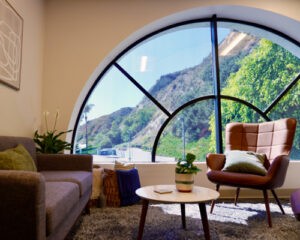“Go outside and get some fresh air!”
We’re sure you’ve heard that tons of times growing up. Maybe you were in a fight with your sibling or upset about something else or another. Whatever it was, you may have thought the adults were just trying to get you out of their hair.
While that may have been true, the primary reason many kids are calmer after going outside is because nature reduces stress and negative mood.
That’s right.
Nature is associated with elevated mood and significantly lower levels of depression, anxiety and stress symptoms (Beyer et al., 2014). It’s also associated with higher cognitive focus (Taylor and Kuo, 2009).
Why Greenspace is Good for Your Mental Health
How does this work? One popular theory, developed by environmental psychology professors Rachel and Stephen Kaplan in the 1970s, states that being in an urban environment causes our mind to work hard to overcome our stimulation-heavy surroundings. This hard work results in “mental fatigue.” When you gaze at nature—grass, trees, lakes, flowers, etc.—you let your mind relax from its never-ending stimuli. The name of this theory is thus, aptly, Attention Restoration Theory.
You know when you’ve been staring at your homework, phone or laptop all day? And your brain hurts from all that concentration and reading and responding to texts and emails? That can be an extreme form of mental fatigue. You can also get mental fatigue from just being around an urban environment too much – staring at too much brick and pavement, too many skyscrapers, too many cars and apartment buildings. Because you are working too hard to ignore all the car horns beeping, the billboards screaming for your attention, the people rushing past you on the sidewalk, your mind gets drained. When you finally get a chance to go to the beach, or even a quiet, grassy park, there are fewer stimuli. Thus, your Focus and Attention (capitalized here for emphasis) have a chance to relax and recharge. So you feel better.
It’s basically like giving your brain a vacation.
Apparently, even just looking at photos of nature works, as seen in several studies like this one. But while all greenery achieves this mind-restoring effect, the best natural scenes to look at are apparently ones with a high “fascination” or “awe-inspiring” value. Staring at the ocean, walking through a huge California Redwood, gazing down at the view from a high mountain– these all fit the category.
Nature Will Actually Decrease Your Depression
Not only have researchers found that greenspace correlates with higher mood, they have found that nature actually decreases one’s depression. In one study (Berman, et al 2012), researchers asked twenty clinically depressed college students to take a 50-minute stroll through nature, specifically, a tree-lined park near campus. These students had significantly lower levels of depression after the nature walk than before the walk. The researchers also asked the participants to take a comparative walk in an urban setting—downtown Michigan, which is traffic-heavy and lined with office buildings—the next week. They did this to make sure that any positive effect was actually because of the time spent in nature, not because the participants took a walk.
For teens with clinical depression or anxiety, spending time in nature outdoors involves a no-risk, non-intrusive mode of therapy. Even just being close to nature (having access to scenic views from a window, for instance) counts. It is for this reason that ample greenspace surrounds many adolescent mental health residential treatment centers (RTC). Many mental health treatment centers are located in rural, scenic areas—near forests, state parks, creeks, the beach, and more—to take advantage of this free therapeutic effect. Even better, select programs offer teens the chance to engage directly with nature through experiential therapies, such as mindful walking, hiking, gardening, surfing, and more.
So, if searching for a teen mental health treatment center for yourself or for your teen, be on the lookout—no pun intended—for scenic views. Of course, a program must check off all the other boxes: robust clinical treatment, high staff-client ratio, and strict safety measures. But it’s a huge plus, therapeutically, if its outdoors are pretty, too.






























































